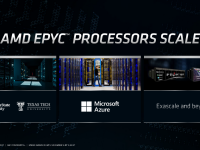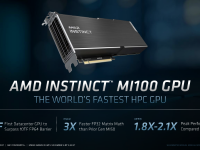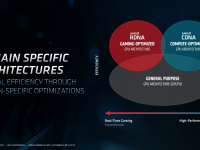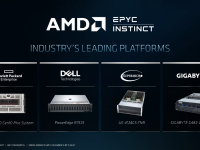AMD stellt Instinct MI100 vor und will Nvidia damit angreifen

Mit der Instinct MI100 stellt AMD einen Gra┬Łfik┬Łbe┬Łschleu┬Łni┬Łger f├╝r das High Per┬Łfor┬Łmance Com┬Łpu┬Łting vor, der AMD nach eige┬Łnen Aus┬Łsa┬Łgen an die Spit┬Łze in die┬Łsem Bereich kata┬Łpul┬Łtie┬Łren soll. Neben den rei┬Łnen Per┬Łfor┬Łmance┬Łver┬Łbes┬Łse┬Łrun┬Łgen soll dies auch durch einen Aus┬Łbau des Soft┬Łware┬Ł├Čko┬Łsys┬Łtems erreicht wer┬Łden. Dazu soll vor allem die neue Ver┬Łsi┬Łon 4.0 der Rade┬Łon Open Com┬Łpu┬Łte Plat┬Łform (ROCm) beitragen.
Instinct MI100
Die AMD Instinct MI100-GPU ŌĆö dem ein oder ande┬Łrem viel┬Łleicht bereits unter dem Code┬Łna┬Łmen ŌĆ£Arc┬ŁturusŌĆØ bekannt ŌĆö basiert auf der neu┬Łen AMD CDNA-Archi┬Łtek┬Łtur und soll laut AMD vor allem in Kom┬Łbi┬Łna┬Łti┬Łon mit AMD EPYC-Pro┬Łzes┬Łso┬Łren der 2. Gene┬Łra┬Łti┬Łon eine neue Klas┬Łse bei den Beschleu┬Łni┬Łger┬Łkar┬Łten f├╝r HPC und AI dar┬Łstel┬Łlen. Sie besteht aus 120 Com┬Łpu┬Łte Units und 7.680 Streamprozessoren.
Die Instinct MI100 bie┬Łtet bis zu 11,5 TFlops bei FP64 und bis zu 46,1 TFLOPS bei FP32-Matrix f├╝r AI- und maschi┬Łnel┬Łles Ler┬Łnen. Mit einer neu┬Łen AMD Matrix Core genann┬Łten Tech┬Łno┬Łlo┬Łgie soll die MI100 im Ver┬Łgleich zu AMDs Beschleu┬Łni┬Łgern der vor┬Łhe┬Łri┬Łgen Gene┬Łra┬Łti┬Łon eine fast 7ŌĆæfache Stei┬Łge┬Łrung der theo┬Łre┬Łti┬Łschen FP16-Spit┬Łzen-Gleit┬Łkom┬Łma-Leis┬Łtung f├╝r KI-Trai┬Łnings-Workloads erreichen.

Mit Bfloat16 (brain floa┬Łting point with 16 bits) wird nun auch ein neu┬Łes Gleit┬Łkom┬Łma┬Łfor┬Łmat unter┬Łst├╝tzt, wel┬Łches bereits bei Intel in Pro┬Łzes┬Łso┬Łren und FPGAs sowie bei NVI┬ŁDI┬ŁAs A100 zum Ein┬Łsatz kommt und beson┬Łders f├╝r maschi┬Łnel┬Łles Ler┬Łnen gebraucht wird.

Angriff auf Nvidias A100?
Laut AMD will man mit der neu┬Łen Beschleu┬Łni┬Łger┬Łkar┬Łte Instinct MI100 Nvi┬Łdi┬Łas Spit┬Łzen┬Łpro┬Łdukt A100 in zahl┬Łrei┬Łchen F├żl┬Łlen ├╝ber┬Łtref┬Łfen, in Berei┬Łchen, in denen dies nicht m├Čg┬Łlich ist, will man aller┬Łdings bei der Per┬Łfor┬Łmance-per-Dol┬Łlar Metrik vor┬Łne liegen.

Ob die┬Łser Angriff gelingt, wird sich erst in der Zukunft zei┬Łgen. Aller┬Łdings hat man bei AMD bereits zahl┬Łrei┬Łche Super┬Łcom┬Łpu┬Łter ange┬Łk├╝n┬Łdigt, die auf eine Kom┬Łbi┬Łna┬Łti┬Łon von AMD Instinct und Epyc ŌĆö also Beschleu┬Łni┬Łger┬Łkar┬Łten und Pro┬Łzes┬Łso┬Łren ŌĆö set┬Łzen. An der Spit┬Łze die Exas┬Łcale┬Łsys┬Łte┬Łme Fron┬Łtier und El Capitan.
Unterst├╝tzung von den gro├¤en Serverherstellern
Zum Start pr├ż┬Łsen┬Łtiert man dann auch die Unter┬Łst├╝t┬Łzung von Ser┬Łver┬Łher┬Łstel┬Łlern wie Dell, Giga┬Łbyte, Hew┬Łlett Packard Enter┬Łpri┬Łse (HPE) und Supermicro.
Dell
ŌĆ£Dell EMC PowerEdge ser┬Łvers will sup┬Łport the new AMD Instinct MI100, which will enable fas┬Łter insights from data. This would help our cus┬Łto┬Łmers achie┬Łve more robust and effi┬Łci┬Łent HPC and AI results rapidly,ŌĆØ said Ravi Pen┬Łde┬Łkan┬Łti, seni┬Łor vice pre┬Łsi┬Łdent, PowerEdge Ser┬Łvers, Dell Tech┬Łno┬Łlo┬Łgies. ŌĆ£AMD has been a valued part┬Łner in our sup┬Łport for advan┬Łcing inno┬Łva┬Łti┬Łon in the data cen┬Łter. The high-per┬Łfor┬Łmance capa┬Łbi┬Łli┬Łties of AMD Instinct acce┬Łle┬Łra┬Łtors are a natu┬Łral fit for our PowerEdge ser┬Łver AI & HPC portfolio.ŌĆØ
Giga┬Łbyte
ŌĆ£WeŌĆÖre plea┬Łsed to again work with AMD as a stra┬Łte┬Łgic part┬Łner offe┬Łring cus┬Łto┬Łmers ser┬Łver hard┬Łware for high per┬Łfor┬Łmance com┬Łpu┬Łting,ŌĆØ said Alan Chen, assistant vice pre┬Łsi┬Łdent in NCBU, GIGABYTE. ŌĆ£AMD Instinct MI100 acce┬Łle┬Łra┬Łtors repre┬Łsent the next level of high-per┬Łfor┬Łmance com┬Łpu┬Łting in the data cen┬Łter, brin┬Łging grea┬Łter con┬Łnec┬Łti┬Łvi┬Łty and data band┬Łwidth for ener┬Łgy rese┬Łarch, mole┬Łcu┬Łlar dyna┬Łmics, and deep lear┬Łning trai┬Łning. As a new acce┬Łle┬Łra┬Łtor in the GIGABYTE port┬Łfo┬Łlio, our cus┬Łto┬Łmers can look to bene┬Łfit from impro┬Łved per┬Łfor┬Łmance across a ran┬Łge of sci┬Łen┬Łti┬Łfic and indus┬Łtri┬Łal HPC workloads.ŌĆØ
Hew┬Łlett Packard Enter┬Łpri┬Łse (HPE)
ŌĆ£Cus┬Łto┬Łmers use HPE Apol┬Łlo sys┬Łtems for pur┬Łpo┬Łse-built capa┬Łbi┬Łli┬Łties and per┬Łfor┬Łmance to tack┬Łle a ran┬Łge of com┬Łplex, data-inten┬Łsi┬Łve workloads across high-per┬Łfor┬Łmance com┬Łpu┬Łting (HPC), deep lear┬Łning and ana┬Łly┬Łtics,ŌĆØ said Bill Man┬Łnel, vice pre┬Łsi┬Łdent and gene┬Łral mana┬Łger, HPC at HPE. ŌĆ£With the intro┬Łduc┬Łtion of the new HPE Apol┬Łlo 6500 Gen10 Plus sys┬Łtem, we are fur┬Łther advan┬Łcing our port┬Łfo┬Łlio to impro┬Łve workload per┬Łfor┬Łmance by sup┬Łport┬Łing the new AMD Instinct MI100 acce┬Łle┬Łra┬Łtor, which enables grea┬Łter con┬Łnec┬Łti┬Łvi┬Łty and data pro┬Łces┬Łsing, along┬Łside the 2nd Gen AMD EPYCŌäó pro┬Łces┬Łsor. We look for┬Łward to con┬Łti┬Łnuing our col┬Łla┬Łbo┬Łra┬Łti┬Łon with AMD to expand our offe┬Łrings with its latest CPUs and accelerators.ŌĆØ
Super┬Łmi┬Łcro
ŌĆ£WeŌĆÖre exci┬Łted that AMD is making a big impact in high-per┬Łfor┬Łmance com┬Łpu┬Łting with AMD Instinct MI100 GPU acce┬Łle┬Łra┬Łtors,ŌĆØ said Vik Malya┬Łla, seni┬Łor vice pre┬Łsi┬Łdent, field appli┬Łca┬Łti┬Łon engi┬Łnee┬Łring and busi┬Łness deve┬Łlo┬Łp┬Łment, Super┬Łmi┬Łcro. ŌĆ£With the com┬Łbi┬Łna┬Łti┬Łon of the com┬Łpu┬Łte power gai┬Łned with the new CDNA archi┬Łtec┬Łtu┬Łre, along with the high memo┬Łry and GPU peer-to-peer band┬Łwidth the MI100 brings, our cus┬Łto┬Łmers will get access to gre┬Łat solu┬Łti┬Łons that will meet their acce┬Łle┬Łra┬Łted com┬Łpu┬Łte requi┬Łre┬Łments and cri┬Łti┬Łcal enter┬Łpri┬Łse workloads. The AMD Instinct MI100 will be a gre┬Łat addi┬Łti┬Łon for our mul┬Łti-GPU ser┬Łvers and our exten┬Łsi┬Łve port┬Łfo┬Łlio of high-per┬Łfor┬Łmance sys┬Łtems and ser┬Łver buil┬Łding block solutions.ŌĆØ





















